Mandala art dazzles with perfect symmetry and eye-popping colors. These circular designs, rooted in ancient traditions, feature intricate patterns that radiate from a central point. Artists create mandalas using everything from colored sand to digital tools, with each piece showcasing mathematical precision. Popular designs include sunflower mandalas, rainbow-hued creations, and nature-inspired patterns. Beyond their beauty, these mesmerizing artworks offer therapeutic benefits, calming the mind while delighting the senses. The world of mandala magic awaits.
Key Takeaways
- Sunflower mandalas combine symmetrical petal arrangements with vibrant yellows and oranges to evoke positive energy and natural harmony.
- Rainbow-themed mandalas use color progression to create visual movement while maintaining perfect geometric balance from the center.
- Digital mandala designs experiment with layered effects and precise symmetry that would be difficult to achieve with traditional tools.
- Nature-inspired mandalas incorporate organic elements like leaves and flowers while maintaining mathematical precision in their patterns.
- Contrasting color mandalas use complementary hues to enhance pattern visibility and create striking visual dynamics across the circular design.
The Ancient Origins of Mandala Art Through History
Thousands of years ago, the powerful symbol of the mandala first emerged across ancient civilizations, capturing the imagination of spiritual seekers and artists alike. These circular patterns, derived from the Sanskrit word for “circle,” represented unity and wholeness in cultures spanning continents.
Hindu and Buddhist traditions embraced mandala art as meditation tools, creating intricate geometric patterns that guided practitioners toward spiritual enlightenment.
What’s fascinating is how similar circular designs appeared independently in Native American sand paintings and even ancient Greek art—proving that humans everywhere are drawn to these symmetrical wonders!
Artists historically used natural materials like colored sand, flowers, and earthy pigments to craft their mandalas, connecting their artwork directly to the natural world around them.
Geometric Precision: The Mathematics Behind Mandala Symmetry
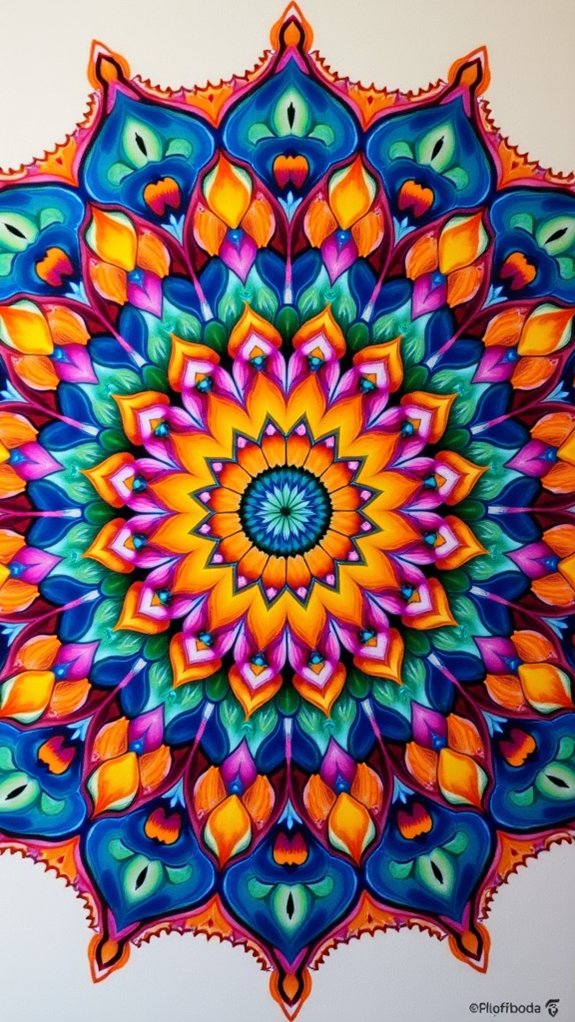
Mandala creation relies heavily on circle division principles, where artists split perfect circles into equal parts to form the foundation of their designs.
They use basic math to determine exactly how many sections to create, ensuring each piece of the pattern sits in perfect balance with the others.
The incredible symmetry happens when these divided sections get filled with matching patterns that radiate outward from the center, creating a hypnotic effect that seems almost magical but is actually pure mathematics in action!
Circle Division Principles
At the heart of beautiful mandala creations lies a hidden language of numbers and angles. Artists divide the circular space into equal parts using specific degree measurements, like cutting a pizza into perfectly matching slices! This circular division creates a framework where every element finds its proper place, allowing the circular pattern to expand outward with flawless symmetry.
Using simple tools like compasses and protractors, mandala artists transform basic math into stunning art. When a circle gets split into segments of 30°, 45°, or 60°, the resulting spaces provide a blueprint for adding details that mirror each other perfectly.
This mathematical foundation, though invisible in the finished piece, gives mandalas their mesmerizing quality. The circular design becomes a visual celebration of geometry that’s both precise and wonderfully creative!
Radial Pattern Mathematics
The hidden magic of radial pattern mathematics transforms ordinary circles into extraordinary mandala masterpieces. Artists engage in radial symmetry exploration by dividing circles into equal parts—like cutting a pie—creating balanced designs that flow outward from the center. These mathematical principles aren’t just useful; they’re the secret sauce that makes mandalas so mesmerizing!
| Pattern Type | Math Concept | Difficulty Level |
|---|---|---|
| Basic Radial | 4-8 divisions | Beginner |
| Complex Radial | 12+ divisions | Intermediate |
| Fractal | Self-similarity | Advanced |
| Golden Ratio | 1.618 proportions | Expert |
When artists apply compass techniques application correctly, they create perfectly aligned patterns that seem to dance around the center point. Fractal patterns analysis reveals how tiny repeating elements build incredible complexity—just like nature does with snowflakes and flowers!
Cultural Expressions: How Different Traditions Interpret Mandalas
Throughout history, diverse cultures have embraced and reimagined mandalas in fascinating ways, each adding their unique artistic fingerprint to these circular designs.
From ancient temples to modern galleries, mandalas speak the universal language of sacred geometry through cultural dialects worldwide.
Mandalas in Hinduism represent the cosmos and divine unity, often featuring intricate patterns that guide meditation practices. Indian traditions use vibrant colors and detailed symmetry, while Native American communities create sand mandalas that honor their connection to nature.
Mexican artists incorporate traditional symbols into their cultural symbolism exploration, creating mandalas that tell stories of heritage and community beliefs.
These varied interpretations have influenced mandalas in contemporary art, where therapists now use them for emotional healing across cultures.
Whether represented with bold colors or subtle earth tones, mandalas continue to bridge spiritual practices and artistic expression, showing how one geometric form can speak so many different cultural languages!
Vibrant Color Theory: Creating Harmony in Mandala Designs
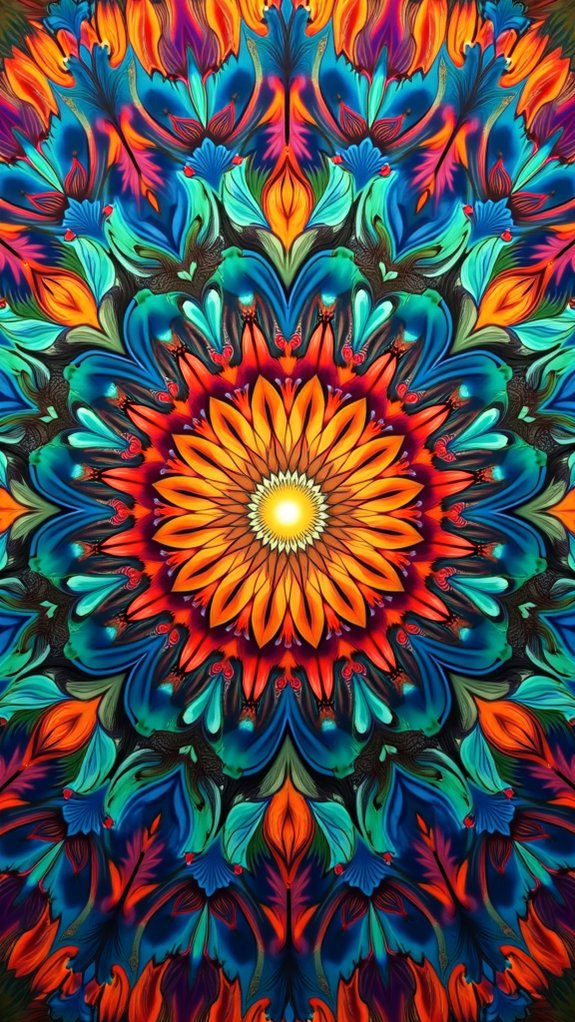
Color breathes life into mandala designs, transforming simple geometric patterns into vibrant expressions of emotion and meaning. Through careful color symbolism exploration, artists create mandalas that speak to viewers on multiple levels. The emotional color impact is powerful – blues might evoke tranquility while reds stimulate energy and passion.
- Rainbow color schemes create a sense of completeness and unity
- Contrasting color techniques enhance pattern visibility and draw the eye
- Complementary colors (opposite on the color wheel) create exciting visual pop
- Analogous colors (neighbors on the color wheel) create smooth, flowing shifts
- Background colors can dramatically change a mandala’s mood and impact
Holographic effects and glitter additions take these designs to another level, creating magical, light-catching mandalas that seem to dance with movement when viewed from different angles!
Ink and Beyond: Materials and Techniques for Crafting Mandalas
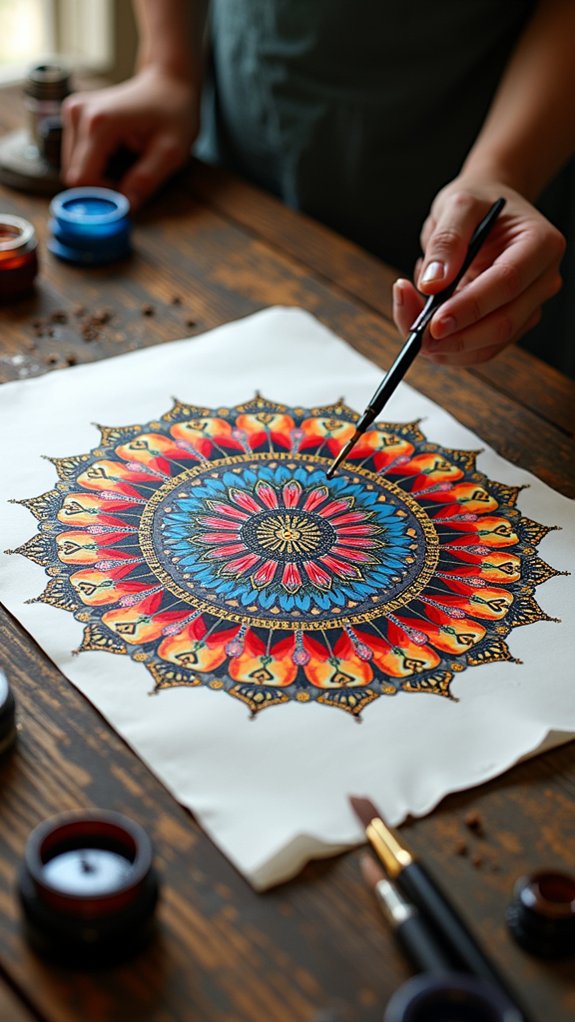
Creating mesmerizing mandala art requires not only vision and patience but also the right materials and techniques that bring these sacred designs to life. Artists often start with fine liners for precise ink techniques, carefully building intricate patterns that seem to dance across the page.
The magic doesn’t stop there—watercolor blending adds vibrant life to these geometric wonders, with colors flowing and merging like dreams taking shape!
Modern mandala creators aren’t limited to traditional tools either. Digital tools have revolutionized this ancient art form, allowing artists to experiment with layers and effects that would be impossible with physical materials.
Whether using a delicate brush, a steady hand with ink, or a tablet with stylus, the meditative process remains the same—creating symmetrical beauty that captivates the eye and calms the mind.
Nature-Inspired Mandala Patterns and Their Symbolism
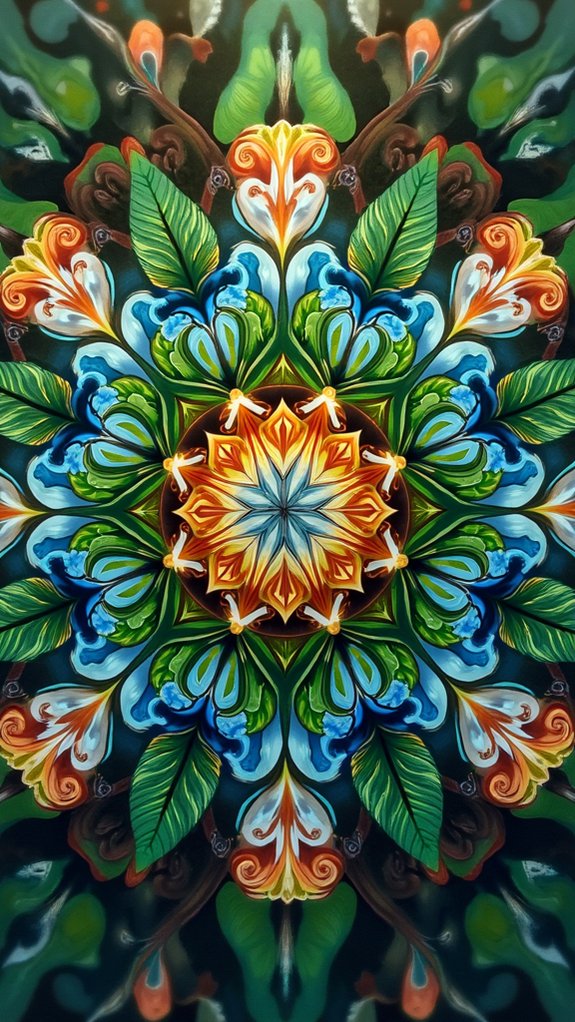
Nature transforms into stunning mandala art when artists reimagine flowers, leaves, and vines as symmetrical patterns that burst with life.
Earth, water, fire, and air don’t just exist in our world—they become magical symbols when arranged in perfectly balanced designs that tell stories about our connection to the planet.
These natural mandalas, with their mirrored elements from the environment, remind us that beauty in nature follows mathematical patterns, just like the golden ratio found in sunflower seeds or the spiral of a seashell.
Floral Patterns Reimagined
Blooming across the canvas of mandala art, floral patterns have captivated artists and viewers for centuries with their natural beauty and symbolic depth.
These reimagined designs showcase the mandala pattern evolution while inviting a deeper floral symbolism exploration. Artists cleverly weave petals, stems, and leaves into geometric frameworks that pulse with life and meaning.
- Lotus flowers often center these designs, representing spiritual awakening and purity
- Swirling rose patterns symbolize love and passion, creating dynamic visual movement
- Sunflower mandalas radiate positive energy and mirror nature’s mathematical precision
- Layered petals create depth, mimicking how flowers unfold in nature
- Color emotion connection is evident as blues bring calm, while reds spark excitement
Each bloom within these circular masterpieces tells a story, connecting us to nature’s perfect symmetry.
Earth Elements Symmetry
The ancient wisdom of earth elements flows through nature-inspired mandala patterns, capturing the perfect balance found in our world. These intricate designs showcase earth harmony symbolism through organic shapes like spiraling leaves, blossoming flowers, and gentle waves.
Artists use earthy greens, rich browns, and calming blues to ground viewers in nature’s embrace.
The beauty of organic shape exploration in mandalas isn’t just pretty—it’s meaningful! Each curve and line represents balance in ecosystems, reminding us how everything in nature works together. Like a forest where every creature plays its part, these mandalas tell stories of connection and stability.
People who meditate with earth element mandalas often feel more peaceful and linked to their surroundings. Isn’t it amazing how art can help us feel more at home in our world?
Digital Mandala Art: Modern Approaches to Traditional Designs
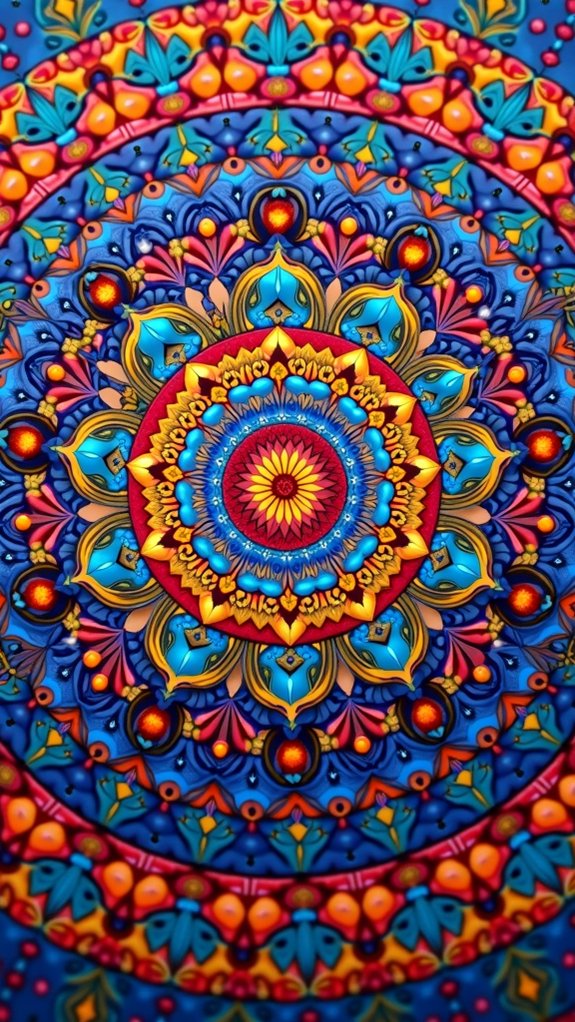
Digital mandala art has revolutionized the ancient practice of creating these sacred geometric designs, giving artists powerful new tools for expression.
Software like Adobe Illustrator and Procreate offer incredible creative flexibility, letting artists play with colors and patterns in ways traditional methods can’t match. These digital tools have also connected a global community of mandala enthusiasts who share tips, inspiration, and gorgeous designs online!
- Artists can undo mistakes instantly (no more starting over!)
- Digital layers make complex designs way easier to manage
- Color palettes can be changed with just a few clicks
- Work can be saved in multiple formats for different uses
- Designs can be perfectly symmetrical thanks to digital guides
This tech-meets-tradition approach has breathed new life into mandala creation, making it accessible to everyone with a tablet or computer.
Therapeutic Benefits of Creating and Observing Mandalas
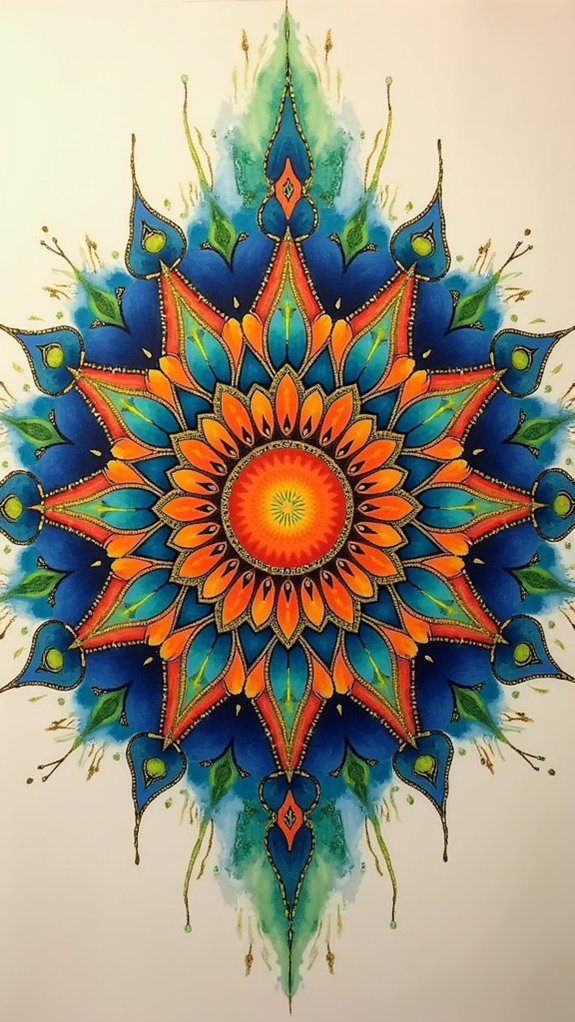
Beyond mere artistic expression, mandala creation offers powerful mental health benefits that researchers and therapists increasingly recognize. The circular designs naturally encourage mindfulness practices, helping people focus on the present moment while their worries melt away.
When someone sits down to color or draw a mandala, they enter a peaceful zone where stress doesn’t stand a chance!
The repetitive patterns in mandalas spark emotional healing as people process feelings through creative expression. It’s like giving your brain a mini-vacation!
Studies show that mandala work activates brain regions linked to problem-solving, which explains why many people report feeling mentally refreshed afterward. For kids struggling with anxiety or big emotions, mandala activities provide a fun, non-threatening way to calm down and boost self-confidence.
The best part? Anyone can experience these benefits—no artistic talent required!
Found Object Mandalas: Everyday Items Transformed Into Art
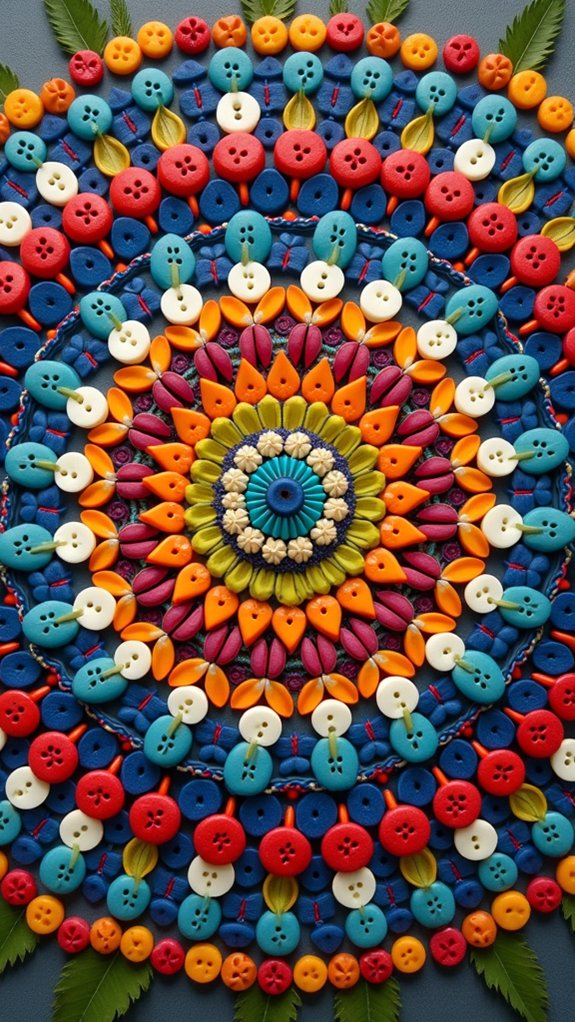
While traditional mandalas often feature intricate designs on paper or canvas, found object mandalas transform ordinary items into extraordinary works of art!
Artists like James Brunt gather natural materials from their surroundings—leaves, pebbles, and even discarded items—arranging them in mesmerizing patterns that celebrate nature’s beauty. The creative process isn’t just artistic; it’s a mindful practice that connects people with their environment!
Environmental artists transform nature’s gifts into ephemeral masterpieces, creating not just art but moments of mindful connection with our world.
- Pebbles, leaves, and twigs become stunning geometric patterns when thoughtfully arranged.
- Each mandala is totally unique and temporary, making them extra special.
- The environmental impact is positive since artists use what nature provides without waste.
- Creating these mandalas helps people slow down and notice beauty in ordinary things.
- Anyone can make them—no fancy art supplies needed, just an eye for finding cool stuff!
From Canvas to Public Spaces: Mandalas in Contemporary Settings

Mandala art has burst beyond the boundaries of traditional canvases into the vibrant cityscape, where artists transform blank walls into mesmerizing circular designs that tell stories of culture and community.
In parks and public gardens, mandala-inspired flower arrangements and stone pathways create peaceful, living art installations that change with the seasons and invite visitors to pause and reflect.
Perhaps most magical are the temporary mandala creations that appear on beaches at low tide, intricate patterns of shells, seaweed, and colored sand that celebrate the beauty of impermanence before being reclaimed by the rising waters.
Urban Canvas Expression
In recent years, urban environments have transformed into living galleries where ancient artistic traditions meet modern expression. Artists have embraced cityscapes as their canvas, creating stunning mandala installations that breathe life into concrete jungles.
These vibrant designs foster urban transformation through artistic collaboration and meaningful community involvement.
- Colorful mandala murals splash across once-boring building walls, turning dreary streets into Instagram-worthy spots.
- Local residents often join artists in creating these pieces, giving everyone a chance to leave their mark.
- The circular designs offer peaceful moments of reflection in busy city settings.
- Mixed media mandalas incorporate urban materials like bottle caps and recycled items.
- These public installations make art accessible to everyone, not just museum-goers.
Mandala Garden Displays
Gardens across the world have blossomed into spectacular living canvases for mandala art, bringing sacred geometry to public spaces in breathtaking ways. Using natural materials like colorful flowers, smooth stones, and fine sand, artists transform ordinary parks and plazas into mesmerizing displays that invite contemplation and wonder.
| Display Type | Materials Used | Community Impact |
|---|---|---|
| Flower Mandalas | Petals, leaves, blooms | Meditation spaces |
| Stone Circles | Pebbles, painted rocks | Gathering points |
| Sand Designs | Colored sand, soil | Interactive workshops |
These installations do more than beautify—they spark community engagement! Visitors often help create these magical patterns, working side-by-side with neighbors they’ve never met. The result? A shared artistic experience that turns strangers into friends while making public spaces more vibrant and meaningful for everyone who passes by.
Temporary Beach Designs
Along the shimmering coastlines of the world, where sea meets sand, artists have discovered nature’s most magnificent canvas for their mandala creations.
These temporary beach designs capture the perfect balance between artistic vision and natural beauty, creating stunning beach aesthetics that fascinate visitors of all ages.
- Sand mandalas stretch across shorelines, using shells, seaweed, and driftwood as decorative elements.
- Interactive installations invite beachgoers to add their own touches to community designs.
- Incoming tides gradually erase these artworks, celebrating the beauty of impermanence.
- Large-scale patterns create amazing photo opportunities against blue ocean backdrops.
- Community engagement happens naturally as curious onlookers gather to watch artists at work.
The fleeting nature of these sandy masterpieces makes them even more special—here today, gone tomorrow, but forever memorable in the hearts of those who experienced them!
Frequently Asked Questions
Can Children Create Meaningful Mandalas Despite Their Limited Artistic Skills?
Children can create meaningful mandalas despite limited skills. Their natural child creativity thrives with mandala simplicity, allowing authentic artistic expression through basic patterns and intuitive color choices.
How Long Does It Typically Take to Complete a Detailed Mandala?
Creating detailed mandalas requires substantial time investment, typically ranging from hours to days depending on complexity. Intricate designs demand artistic patience, with experienced artists often spending 8-20 hours per complex piece.
Are There Taboos or Restrictions When Creating Personal Mandalas?
While creating personal mandalas offers artistic freedom, some practitioners respect cultural sensitivities by avoiding appropriative use of sacred symbols. Personal symbolism remains paramount, allowing authentic self-expression within mindful boundaries.
Can Mandalas Be Effectively Incorporated Into Corporate Branding Designs?
Mandala symbolism can enhance corporate identity through balanced aesthetic appeal. Branding psychology shows mandalas effectively convey harmony and wholeness, making them valuable visual elements in contemporary corporate design strategies.
Do Left-Handed Artists Face Unique Challenges When Creating Circular Mandalas?
Left-handed artists often adapt specialized left-handed techniques when creating circular mandalas. Their natural artistic flow moves differently, offering unique perspectives that can enhance mandala designs with distinctive directional patterns.
Conclusion
Mandalas truly represent the beautiful meeting point of art, math, and spiritual expression. These circular wonders bring people together across cultures and time periods, offering both visual delight and inner peace. Whether drawn with pencils, arranged with flowers, or digitally designed, mandalas remind us that creativity has no limits. So grab some colors, find your center, and let the mesmerizing world of mandalas inspire your own artistic journey!

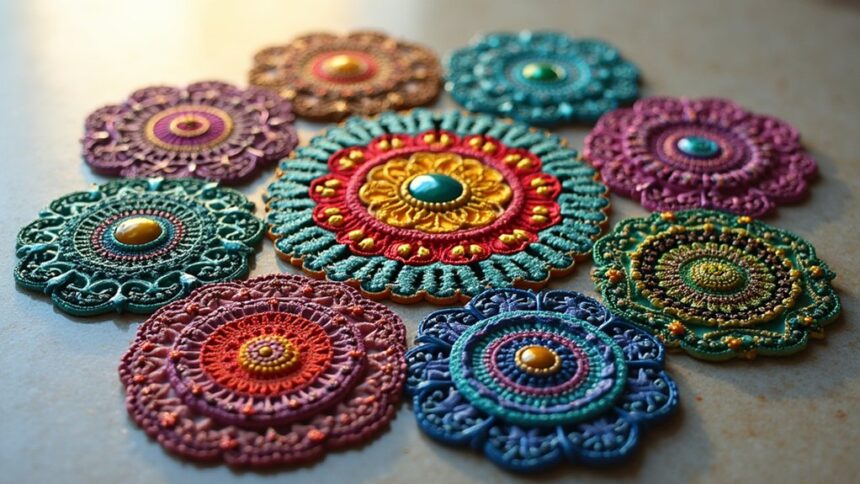
Leave a Reply